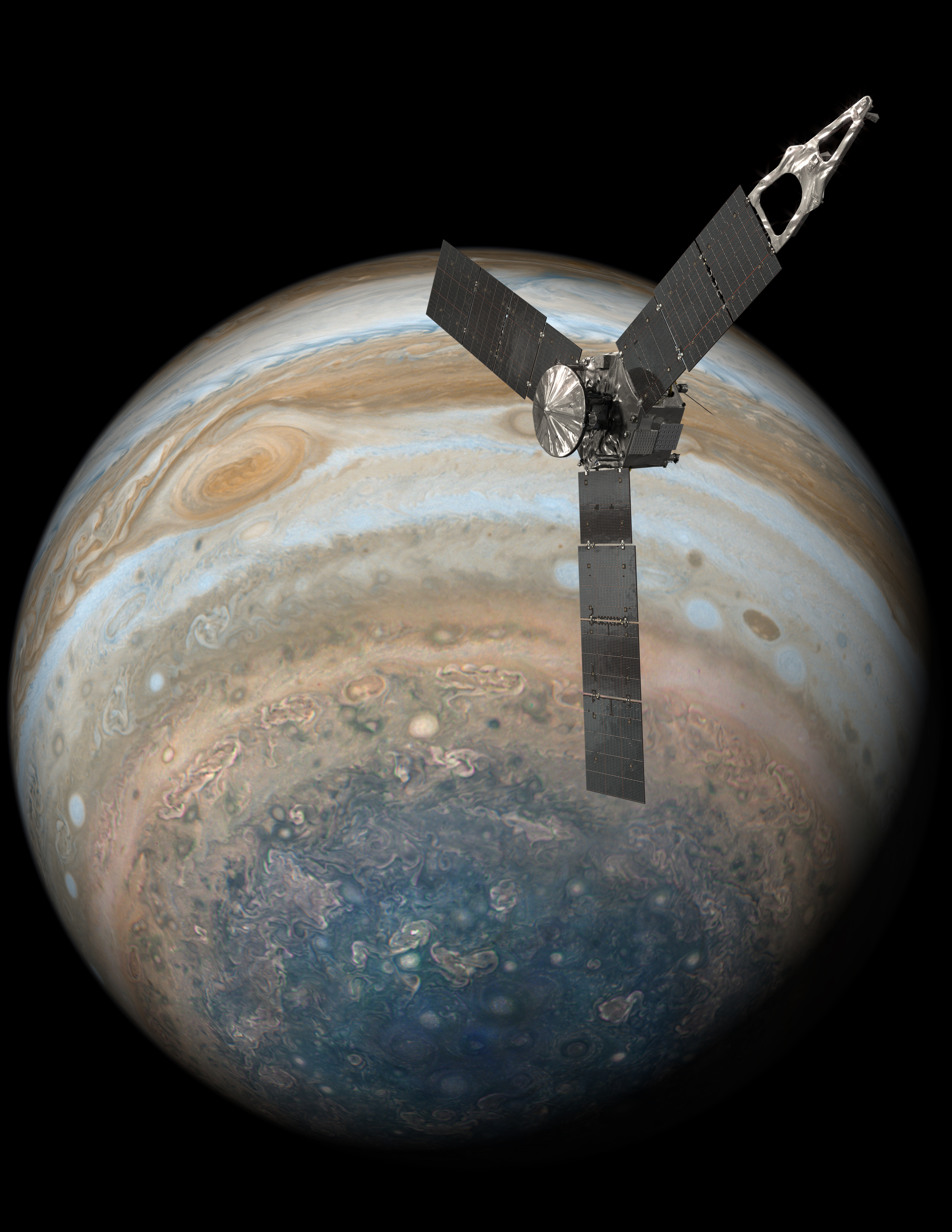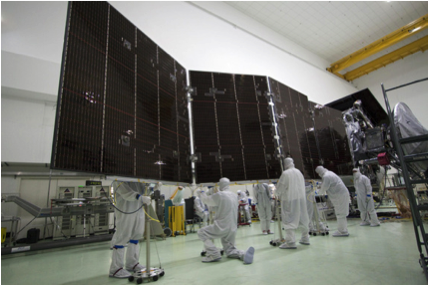
The Juno Spacecraft
Juno Basic Mission Goals
For more information on the Juno Mission see the following:
Data were not acquired during Jupiter Orbit Insertion on July 5, 2016 (perijove 0). Only gravity data was obtained on perijove 2. Additionally, data are missing from most of these 3 orbits (perijove 69-71) due to electrical issues with the instruments.
Other Useful Products for Interpreting the Data
Scheduled Data Releases
Juno is a spin-stabilized spacecraft, powered by 3 large, deployable rigid-panel arrays that can be moved to adjust the spin axis relative to the high gain antennae boresight. The spacecraft utilizes high energy density Li ion batteries for battery-regulated bus voltage. Basic radiation protection for sensitive electronics is afforded by a titanium-walled vault. Telecom is achieved with X-band uplink and downlink. Ka-band telecom is included for improved Doppler measurement performance
Juno Basic Mission Goals
Origins -Determine the abundance of water and place an upper limit on the mass of Jupiter's solid core.
Interior - Understand Jupiter's interior structure and how material moves deep within the planet by mapping its gravitational and magnetic fields.
Atmosphere - Map variations in atmospheric composition, temperature, cloud opacity and dynamics to depths greater than 100 bars at all latitudes.
Magnetosphere - Characterize and explore the three-dimensional structure of Jupiter's polar magnetosphere and auroras.
Interior - Understand Jupiter's interior structure and how material moves deep within the planet by mapping its gravitational and magnetic fields.
Atmosphere - Map variations in atmospheric composition, temperature, cloud opacity and dynamics to depths greater than 100 bars at all latitudes.
Magnetosphere - Characterize and explore the three-dimensional structure of Jupiter's polar magnetosphere and auroras.
For more information on the Juno Mission see the following:
Archive Datasets
Cruise and Earth Flyby Data and
Cruise and Earth Flyby Data and Jupiter Data with both PDS3 and PDS4 labels are available through perijove 71.
Data were not acquired during Jupiter Orbit Insertion on July 5, 2016 (perijove 0). Only gravity data was obtained on perijove 2. Additionally, data are missing from most of these 3 orbits (perijove 69-71) due to electrical issues with the instruments.
Each of the following archived data sets contains documentation of the data and individual data collections of raw, reduced and/or derived data complete with calibration information where applicable.
Microwave Radiometer (MWR) data are stored in ASCII tables with supporting documentation
Ultraviolet Imager/Spectrometer (UVS) data are stored in FITS tables with supporting documentation
Jovian InfraRed Auroral Mapper (JIRAM) data are stored in ASCII tables or Binary tables with supporting documentation
Gravity Science Experiment - raw data are stored in Radio Science Format
Microwave Radiometer (MWR) data are stored in ASCII tables with supporting documentation
Ultraviolet Imager/Spectrometer (UVS) data are stored in FITS tables with supporting documentation
Jovian InfraRed Auroral Mapper (JIRAM) data are stored in ASCII tables or Binary tables with supporting documentation
Gravity Science Experiment - raw data are stored in Radio Science Format
Color Camera (JunoCam) data are archived at the PDS Cartography and Imaging Sciences Node
Stellar Reference Unit data are archived at the PDS Cartography and Imaging Sciences Node
Flux Gate Magnetometer (FGM) data are stored in the Planetary Plasma Interactions Node (PPI) in ASCII tables with supporting documentation
Jupiter Energetic Particle Detector Instrument (JEDI) data are stored in the PPI Node ASCII tables with supporting documentation
Jupiter Auroral Distributions Experiment (JADE) data are stored in the PPI Node ASCII tables with supporting documentation
Radio/Plasma Wave Experiment (WAVES) data are stored in the PPI Node ASCII tables with supporting documentation
Information at MAST of HST + Gemini Wide-Field support imaging
Public access to the JunoCam processed images
Public access to the JunoCam processed images
Stellar Reference Unit data are archived at the PDS Cartography and Imaging Sciences Node
Flux Gate Magnetometer (FGM) data are stored in the Planetary Plasma Interactions Node (PPI) in ASCII tables with supporting documentation
Jupiter Energetic Particle Detector Instrument (JEDI) data are stored in the PPI Node ASCII tables with supporting documentation
Jupiter Auroral Distributions Experiment (JADE) data are stored in the PPI Node ASCII tables with supporting documentation
Radio/Plasma Wave Experiment (WAVES) data are stored in the PPI Node ASCII tables with supporting documentation
Other Useful Products for Interpreting the Data
Publications - A listing of team members to facilitate literature searches
SPICE - Archived Juno SPICE ancillary data providing observation geometry (positions, orientations, instrument pointing, time conversions, etc.) are available from the PDS NAIF Node.
SPICE - Archived Juno SPICE ancillary data providing observation geometry (positions, orientations, instrument pointing, time conversions, etc.) are available from the PDS NAIF Node.
Scheduled Data Releases
 PDS: The Planetary Atmospheres Node
PDS: The Planetary Atmospheres Node



